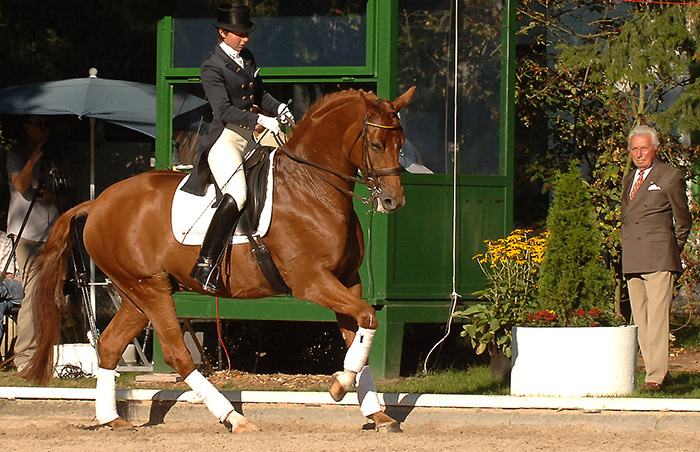
This picture was taken at the 2005 Bundeschampionat where Georg and his daughter Monica, current German dressage coach, were giving a demonstration with Monica’s young Grand Prix horse, Whisper
It was back in 1995 when the German equestrian magazine, Reiter Revue, published a warning from Georg Theodorescu about the direction in which dressage was headed. To illustrate the article, Reiter Revue made silhouettes of leading international riders – more than twenty years later, we add some photos from recent times to show that the warning is just as insightful as it was then…
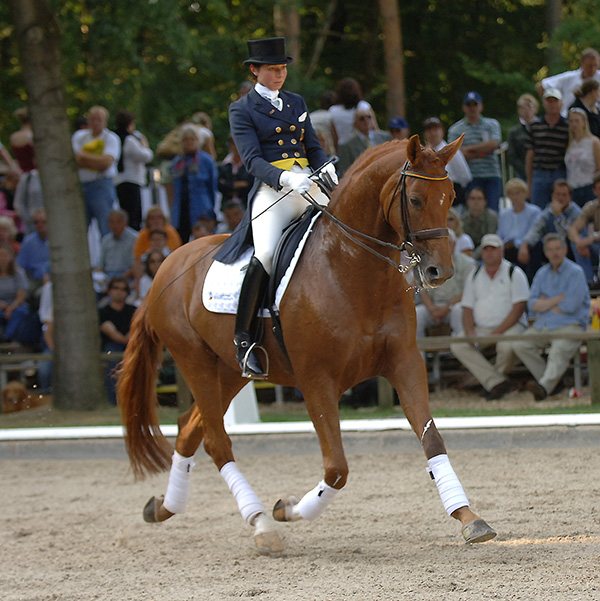
Monica and Whisper in extended trot
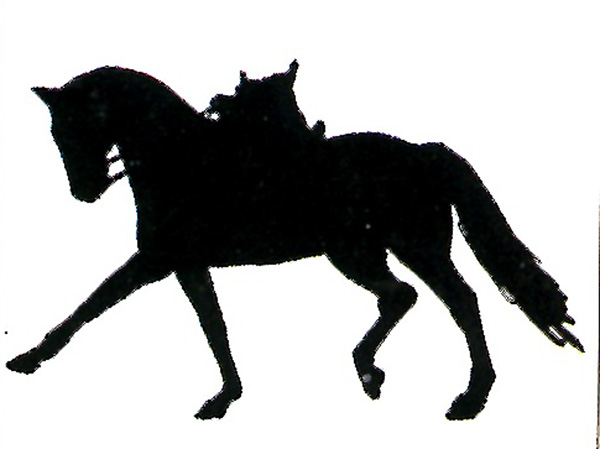
Georg’s comment on this diagram in the original article – Extension behind the vertical
Today you hear again and again of new methods. The question arises where does that lead, what can be so new in dressage riding and training? The horse has remained the same over the last few centuries, even if the quality has improved through selective breeding. But there are training principles that do not change. The forehand of the horse weighs about 80 kg more than the hindquarters – today as well as in former times. Does one not have to train the horse in such a way that the horse comes into balance?
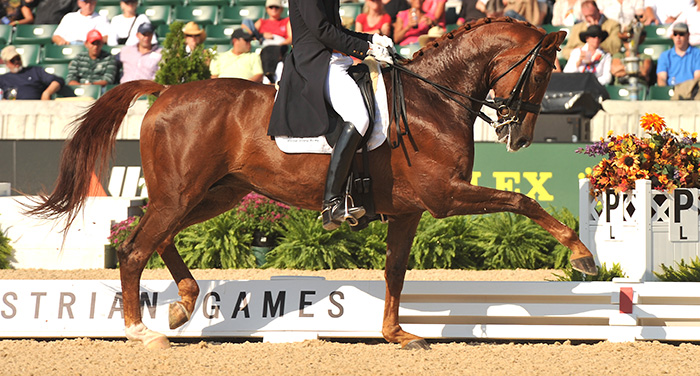
Today at competitions you see more and more horses that are worked from front to back, instead of from back to front.
They flick mightily in front, haunches dragging, tight in the back, and are behind the vertical. Riders are presenting them sometimes faster or slower, but rarely in true collection.
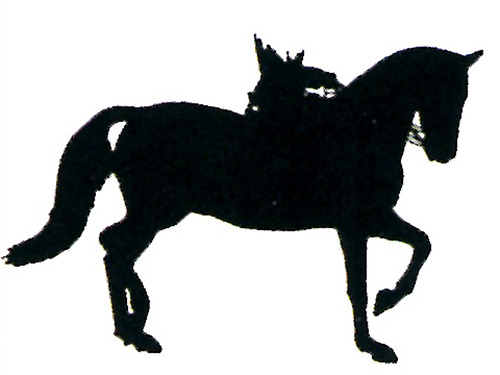
Haunches not carrying well
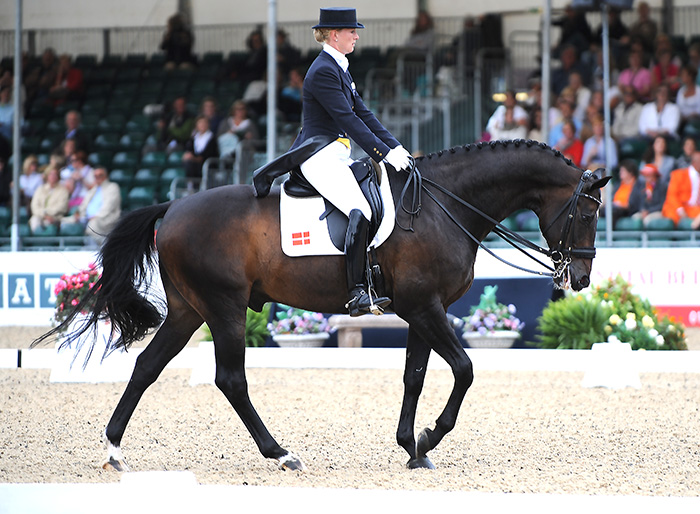
And the walk, the most important gait after all, is mostly not marching anymore but tricked, the horses are just mechanised.
Unfortunately, such performances are often rewarded with high scores – to the great surprise of all the experts. Should judges, riders, and trainers not orientate themselves anew – or better, remember the old general principles?
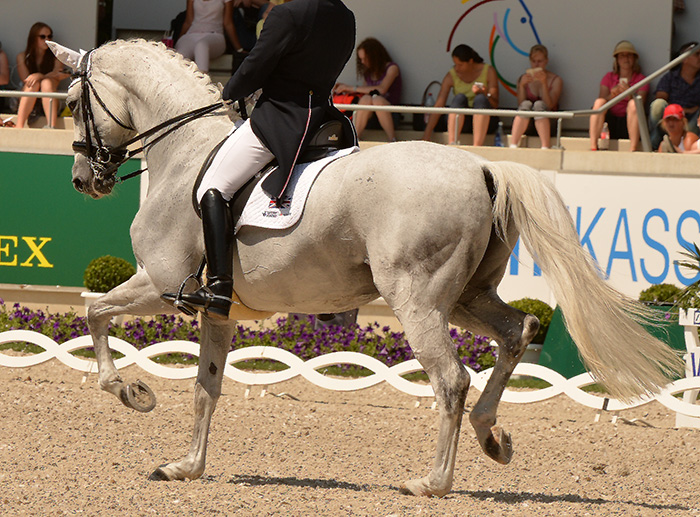
Is it not a fact that the hindquarters are better equipped with ‘springs’ than the forehand? The shock absorption of the haunches is there to take on the weight. When the shock absorbing haunches compress, while accepting the weight, the forehand stretches upwards because the weight is taken off. This is visible for instance over a jump or in the elevated steps of piaffe and passage.
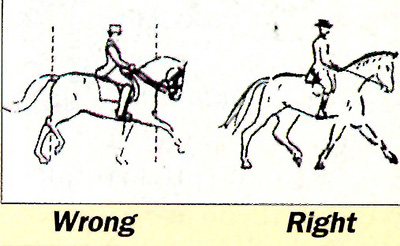
The terms Hankenbug (hock bending) and Unter-den-Schwerpunkt-treten (stepping under the point of gravity) describe this principle that gets more and more lost.
Felix Bürkner once said: “This basic principle lies in the systematic gymnastic development of the haunches to prepare for collection.” Is this statement not true any more? I believe it still is.
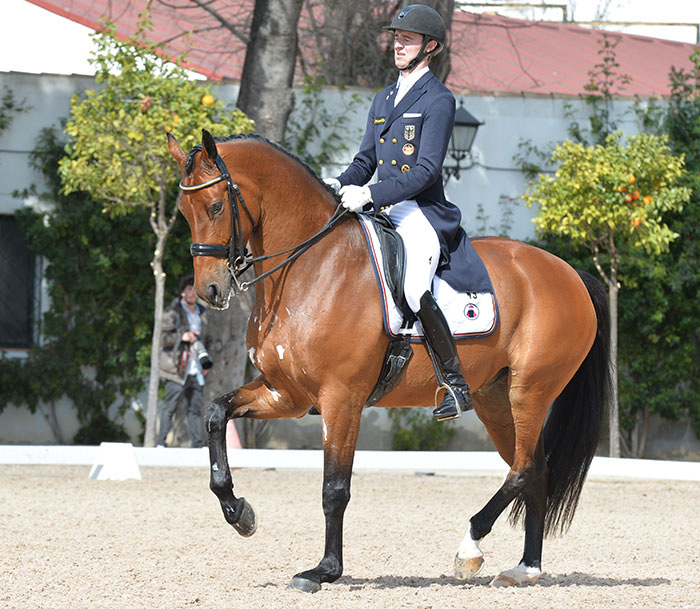
I also still believe that collection is mainly achieved through half-halts and full halts. This principle is found not only in the FEI Reglement International (Par 416) but also in all classical riding manuals that are based on centuries-long experiences.
Müseler, for instance, wrote: “All half-halts are given in the same way, by riding the horse from the back to a non-allowing hand!” What holds for collection is also true for extension. The haunches have to step into the point of gravity as well. Lengthening of the frame yes, but forward, not backwards.”
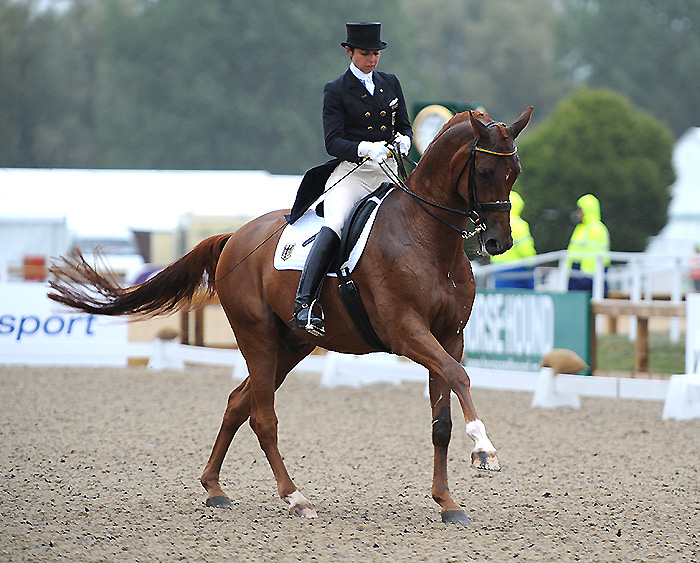
Monica and Whisper at the Euros in Windsor
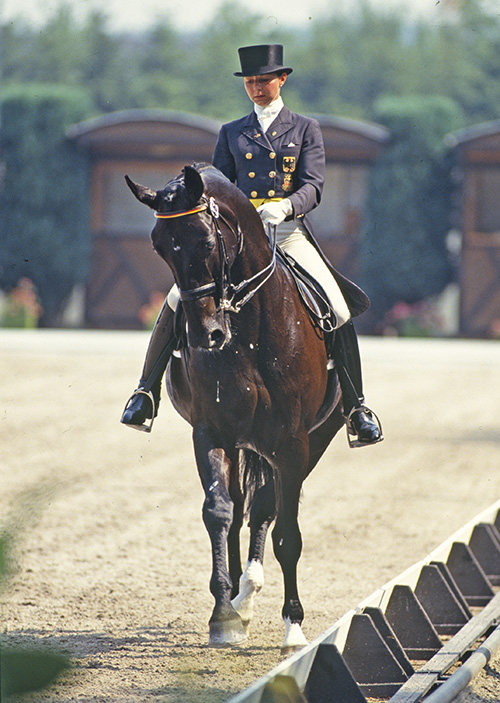
And at Aachen
Felix Bürkner, one of the truly great trainers and riders, once said: “The basics of the well-trained dressage horse are a result of the principles of riding set forth in Regulations that remain valid for all times. Abandoning these century-old experiences causes devastating results. The demand that correct dressage training enhances the beauty of the horse is directly linked to the principle that even an Advanced horse can resume the frame, looseness and relaxation of a Novice horse at any time. Only this principle prevents the rider from creating tension when working on highest collection.”
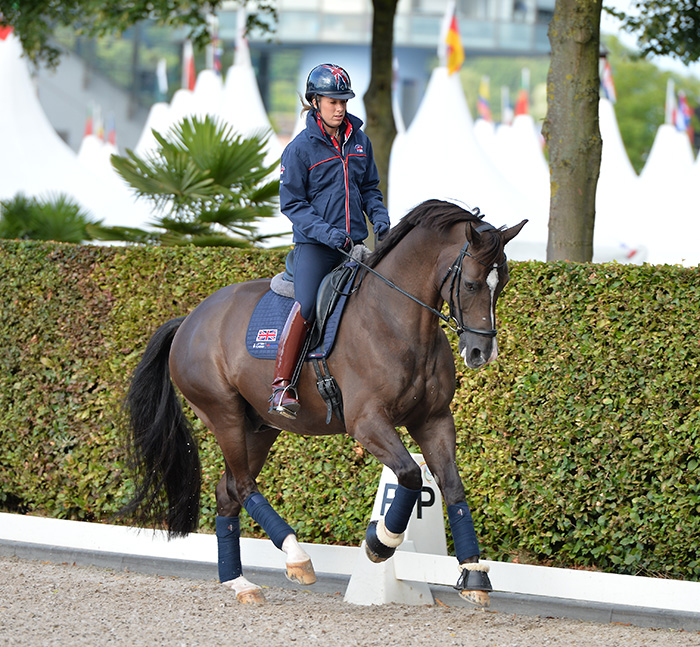
“If the Advanced horse can assume the outline of a Novice horse at any time, he knows the correct basics. Those correct basics, however, are only visible to judges who know in depth about correct training and can look beyond what is shown to them.”
“A judge should not downgrade himself to the status of one who merely registers formal mistakes, but to help the true correct principle to gain victory. Otherwise he hurts the essence of our art of riding and discourages newcomers from riding dressage.”
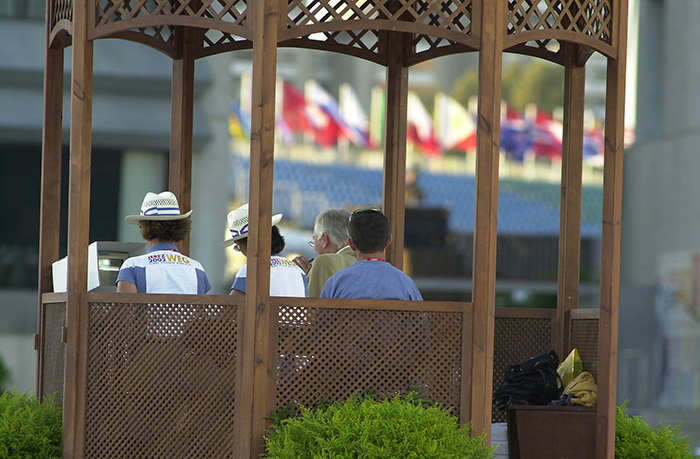
“The dressage competitor on the other hand has to be able to trust the knowledge of the judges, and the judge has to help the beginner riders through his comments to aim for the correct way of riding and to adhere to the proper basics.”
more follows
If today there are judges who reward tests and movements which do not adhere to these principles with high scores, we have to ask ourselves if those principles are still valid or if they need to be changed. However, if the aforementioned principles are still valid, why is dressage training not done accordingly?
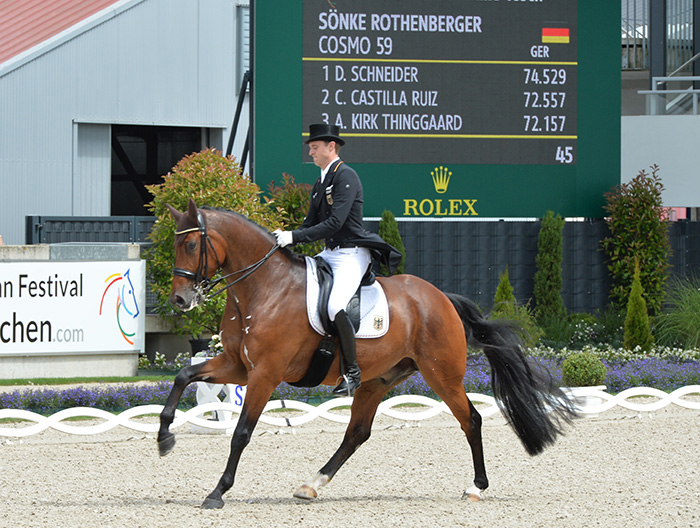
Not only trainers and riders but mainly judges determine the course of dressage through their scores. They should always be aware of this fact, whether they judge Grand Prix or lower levels. If a spectacular but tensely and tightly moving horse gets higher marks in a test than a loose, correctly ridden horse, it is not surprising that more and more riders take the wrong course in the training of their horses.

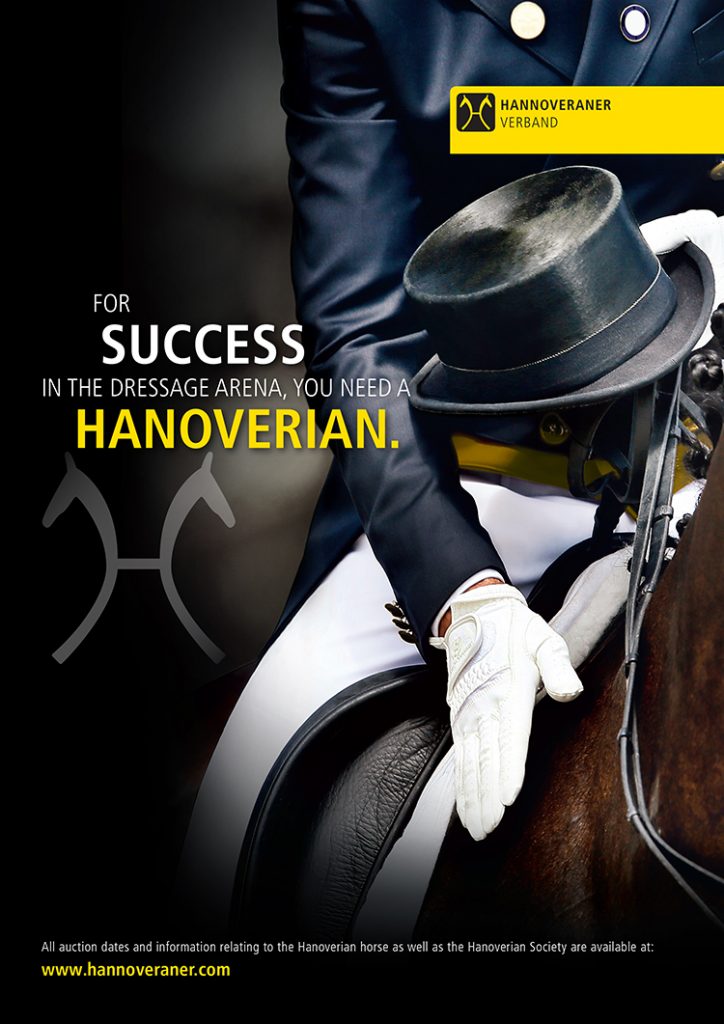
A wonderful and informative article by a Master. How do you pressure the FEI to educate judges? Judges must make appropriate comments in their marks about riders of all levels who ride their horse behind the bit, over bent, however you describe this common fault. They must discourage judges from awarding high marks to these riders and also to horses with exaggerated front end action ( and breeders from producing this type of faulty action). I am surprised to see you using Elizabeth Worth’s promotion advertisement for Bates saddles – I have two photos of her schooling a horse in roll-kur. I used to admire her riding skills, but after seeing her use this dreadful method, I no longer audit her clinics. Same goes for Edward Gal who uses the same method. I would be interested to read the comments by other readers.
Great article. I am an amateaur but I think I have developed an eye for a correct frame. I strive for this in my riding making test movements my second priority. When my horses are supple and carrying their weight with their hind, transitions, laterals etc are smooth and light
To Pru Zerny, I too have seen some troubling photos of Werth, but I think we have to consider two things. 1. These are few and far between, most are from the 90s, and she may have been overflexed for a moment or two (have we all not had this fault at one point, I know I have). 2. She has publicly come out against rolkur. I’m quite keen on holding the Dutch and others accountable for using this technique, but I’m not sure it’s fair to throw Werth in with the rolkur crowd. But, if someone has more current information that I do not have, please share, I open to changing my view if it is based upon incomplete information.
Dressage needs to adhere to the principles of “ THE THREE BEARS” … the children’s story….. we need to dismiss extremes… and end up in a nice comfort zone for the horse……
THANK YOU FOR Å VERY GOOD ARTICLE YOU ARE SO RIGHT THE DRESSAGE ARE DESTROIED TODAY
The art of dressage training is an “art only for the purists who love and respect their horse”. Sadly competition has taken over the purity of the art and money talks all languages. What once was a therapeutic training scale for the horse no longer exists as now the horse is used as a tool to pump up egos.
In my early years I trained with Mestre Nuno Oliveira where the emphasis was on lightening the forehand first in shifting the weight of the horses balance back thus effecting room for the hindquarters to step more forward to carry the weight. Also this was coupled with riding forward asking the horse to stretch its whole back from head to tail. You state that the hindquarters are equipped with “springs” more than the forehand. With respect is it not the powerful “springing” action of a horses muscles involved in its front end to first lift upwards and secondly the hindquarters follow with their carrying/pushing forward capacity.
I have observed that too much emphasis is on a horses engagement of its hindquarters which is still important but a horse that has more weight in front physically than behind needs to be shown through clever use of communication through the hands to bit asking it to lighten the forehand with supplying exercises. Who ever invented the low deep and round with the horse trotting around on the forehand then later in training asking for collection resulting in horses becoming fractious and some international riders using the abusive rollkur!!!!!!
With very real respect to Mr. Theodorescu, I politely disagree on a number of points.
First, enough already with the damned silhouette. Horses come in all shapes and sizes. They are at all stages of training and conditioning over their lifetimes. They are in different stages of their ride every day they’re ridden. To insist that only a narrow range of outlines are pure and anything else is evil and the destruction of our sport is not helpful.
Rather than worry about the shape of the neck, we should be concerned with the way it is achieved. I think we all agree that pulling backwards on the reins to put a horse in any frame is always wrong. However, even with unanimous agreement on this irrefutable principle, we still have a problem. Apparently many people (including some judges) can’t see the difference between a horse reaching forward and a horse being pulled backwards. Still, all is not lost.
There are three guiding principles that determine whether a horse at any level of training is fundamentally correct or not. They are Tempo, Transitions, and Bend. The tempo, number of hoof beats per minute, should remain fairly constant throughout the ride with changes of gait resulting in changes of rhythm, not tempo. Transitions should be done within a single stride. If a horse trying to lengthen or extend requires several strides in which he gets faster as he gets longer, that’s a five… maybe a six if the few longer strides finally achieved are very good. Finally, the horse should always be bent to match the curve he is on and suitably for the movement he is performing. This may sound tricky to see, but the giveaway is a horse cannot maintain correct tempo if he isn’t supple and bending correctly.
It’s been nearly 40 years since the entire rollkur “discussion” has started and it is clear to anyone paying attention it hasn’t moved a meter in all that time. Let’s just put that away and focus our students and young riders on these functional characteristics. I’m optimistic that with time and training even our five star judges can learn to recognize and reward these qualities.
Mike Schaffer
Author of…
“Riding In the Moment, Discover the Hidden Language of Dressage”
“Five Things You Can Do in Thirty Minutes to Improve Your Riding Forever”
“Right From the Start, Create a Sane, Soft Well-Balanced Horse”
There will never be another Georg. I watched many training sessions with him and still remember his wisdom and keen eye. He was worried about the direction of modern dressage and about “tricks” used by many riders. Horses heads would turn and nicker as this legend walked through the barn. It was a very special time.
.02 from a non-expert…
Snapshots/photos can be very deceiving — esp. when the shots are taken at a different point in the phase of the trot or canter — you just can’t make proper comparisons or judgements. Even in good riding there can be awkward strides or moments. If you’re going to post the “goofus and gallant” style photo juxtapositions, at least be fair and show them at the same phase of the trot, the point where one hind is reaching forward in the phase of trot. or the suspended stage of the canter…
Guess we know how commenter Mike rides.
Good article. Dressage needs to be what it’s supposed to be…. ethical, kind, correct. The stuff the FEI allows today is none of that. This current trend has one purpose alone: to entertain audiences with a freak show of flicking feet and animals about to jump out of their skins. Relaxation isn’t important. They want bouncy bouncy marionettes.
Don’t be like the FEI. Be like the Theodorescus, the Klimkes, the Zettls and many more li KY e Christine Stuckelberger.
The main problem is asking for more action and impulsion then the horse is able to handle without loosing its balance, with tension and inaccurate coördination as a consequence. Modern riders strive for the highest mark, with the greatest movements, with the longest suspension. In gymnastics you can make your test more difficult. But in dressage the movements are the same for all. So the improvement is more, more, more. I would suggest that balance, correct coördination and outline would be included in the scores counting double or triple, so that riders and trainers get the right focus. I’m sure that this would greatly improve veterinarian and digestive problems for dressage horses and make space for true understanding of the mechanics in dressage.
The FEI must take the lead on this, otherwise this is a never ending story.
Well, and it was me who had the idea for this article and did all the silhouettes 🙂 We showed much more then just those two. I was the Deputy Editor-in-Chief at the Reiter Revue in those times (under my maiden name Britta Immes). It is too bad, that dressage developed like it did.
Well, let’s be honest – in the last 20 years there are many new judges who grew like mushrooms but who never rode or rode very little on weekend rider level themselves. That is not the main but one of the reasons for the official judging taking the wrong route.
We waste a lot of time talking about what is collection. All we have to do is read Gymnazium by Steinbrecht, and understand it.
There seems to be a complete lack of understanding of what collection really means. The idea of bent haunches and relative elevation are completely forgotten and people who put themselves forward as experts only confuse matters further. Don’t anybody read the old masters anymore.
There are comments on this discussions made by people who write books and show their work on utube, that completely miss the point.
Hi, I was the pupil of Master Egon Von Neindorff, In 1989 in his office he told me the Dressage is finished, the people today want to win, and don’t care for the horse any more!.